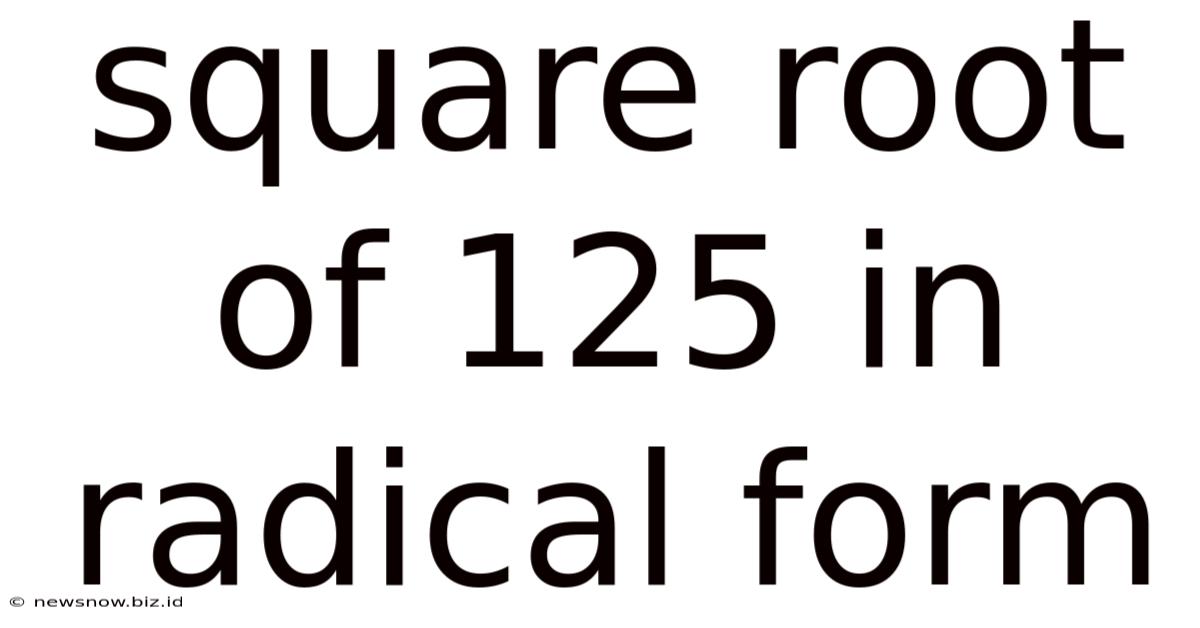Square Root Of 125 In Radical Form
New Snow
May 10, 2025 · 4 min read

Table of Contents
Understanding the Square Root of 125 in Radical Form
The square root of 125, denoted as √125, is an interesting mathematical concept that delves into the realm of radical expressions and prime factorization. While a calculator will readily provide a decimal approximation, understanding how to express √125 in its simplest radical form is crucial for various mathematical applications and demonstrates a foundational understanding of number theory. This comprehensive guide will break down the process, explore related concepts, and provide you with a thorough grasp of this seemingly simple yet insightful mathematical problem.
What is a Radical Expression?
Before diving into the specifics of √125, let's define what a radical expression is. In mathematics, a radical expression is an expression containing a radical symbol (√), which denotes a root (such as a square root, cube root, etc.) of a number or expression. The number or expression under the radical symbol is called the radicand. For example, in the expression √125, the radicand is 125.
The simplest form of a radical expression is one where the radicand contains no perfect squares (or perfect cubes, if it's a cube root, etc.) as factors. Simplifying a radical expression involves finding the largest perfect square that divides the radicand and expressing it as a product of the square root of that perfect square and the remaining factor.
Simplifying √125: A Step-by-Step Approach
To simplify √125, we need to find the prime factorization of 125. Prime factorization is the process of expressing a number as a product of its prime factors (numbers divisible only by 1 and themselves).
-
Find the prime factorization of 125:
125 can be factored as 5 x 25. Further, 25 can be factored as 5 x 5. Therefore, the prime factorization of 125 is 5 x 5 x 5, or 5³.
-
Identify perfect squares:
Looking at the prime factorization (5 x 5 x 5), we see a pair of 5s. This represents a perfect square: 5 x 5 = 25.
-
Simplify the radical:
We can rewrite √125 as √(25 x 5). Using the property of square roots that √(a x b) = √a x √b, we can separate this into: √25 x √5.
-
Evaluate the perfect square:
The square root of 25 is 5. Therefore, our expression becomes 5√5.
Therefore, the simplest radical form of √125 is 5√5. This means that 5√5 multiplied by itself equals 125.
Exploring Related Concepts: Perfect Squares and Cubes
Understanding perfect squares and cubes is fundamental to simplifying radical expressions.
-
Perfect Squares: A perfect square is a number that can be obtained by squaring an integer (multiplying an integer by itself). Examples include 1 (1²), 4 (2²), 9 (3²), 16 (4²), 25 (5²), and so on.
-
Perfect Cubes: A perfect cube is a number that can be obtained by cubing an integer (multiplying an integer by itself twice). Examples include 1 (1³), 8 (2³), 27 (3³), 64 (4³), 125 (5³), and so on.
Identifying perfect squares and cubes within the radicand is crucial for simplifying radical expressions efficiently. If the radicand is a perfect square or cube, the simplification process becomes straightforward.
Applying the Concept to Other Radical Expressions
The method used to simplify √125 can be applied to other radical expressions. For example, let's consider simplifying √72:
-
Prime Factorization: 72 = 2 x 36 = 2 x 6 x 6 = 2 x 2 x 2 x 3 x 3 = 2³ x 3²
-
Identify Perfect Squares: We have a pair of 2s and a pair of 3s, representing 4 (2²) and 9 (3²).
-
Simplify: √72 = √(2² x 2 x 3²) = √(2²) x √(3²) x √2 = 2 x 3 x √2 = 6√2
Therefore, the simplest radical form of √72 is 6√2.
The Importance of Simplifying Radical Expressions
Simplifying radical expressions is not just an exercise in mathematical manipulation. It serves several crucial purposes:
-
Precision: Simplifying provides a more precise and concise representation of the value.
-
Efficiency: Simplified expressions are easier to work with in calculations and algebraic manipulations. Imagine trying to add √72 + √128 without simplifying; it's far more complex than adding 6√2 + 8√2, which simplifies to 14√2.
-
Problem Solving: In various mathematical problems, particularly in geometry and algebra, simplifying radical expressions is often a necessary step towards finding a solution.
Beyond Square Roots: Higher-Order Roots
The principles of simplifying radical expressions extend beyond square roots to higher-order roots, such as cube roots (∛), fourth roots (∜), and so on. The process involves finding perfect cubes, perfect fourths, etc., within the radicand and extracting them from the radical.
Conclusion: Mastering Radical Expressions
Simplifying the square root of 125, and radical expressions in general, is a fundamental skill in mathematics. Understanding prime factorization, perfect squares, and the properties of radicals is key to mastering this technique. The ability to simplify radical expressions efficiently contributes significantly to a deeper understanding of mathematical principles and enhances proficiency in solving a wide range of mathematical problems. Remember, practice is key; the more you work with these expressions, the more intuitive the process will become. From solving simple arithmetic problems to tackling complex algebraic equations, a strong grasp of radical simplification serves as a powerful tool in your mathematical arsenal.
Latest Posts
Related Post
Thank you for visiting our website which covers about Square Root Of 125 In Radical Form . We hope the information provided has been useful to you. Feel free to contact us if you have any questions or need further assistance. See you next time and don't miss to bookmark.